Forex Trading

Forex Trading: A Beginner’s Guide
Forex, short for foreign exchange, is the global decentralized market where currencies are bought, sold, exchanged, and speculated upon. It is the largest financial market in the world, with an average daily trading volume exceeding $6 trillion. Forex trading offers opportunities for investors to profit from the fluctuations in exchange rates between different currency pairs. If you’re new to forex trading, this comprehensive guide will walk you through the step-by-step process of getting started.
1. Understanding Forex Basics
What is Forex? Forex is the market where participants can buy, sell, exchange, and speculate on currencies. Currencies are traded in pairs (e.g., EUR/USD, GBP/JPY), where the value of one currency is compared to another. For instance, if the EUR/USD exchange rate is 1.2000, it means one Euro is worth 1.2000 US dollars.
Why Trade Forex? Forex trading offers several benefits, including high liquidity, 24-hour market availability (except weekends), low transaction costs, and the ability to profit in both rising and falling markets.
2. Key Players in the Forex Market
Central Banks: Central banks are key players in the forex market. They implement monetary policies and intervene in the market to stabilize their national currencies.
Commercial Banks: Banks facilitate the majority of forex transactions for their clients, including individuals, businesses, and governments.
Hedge Funds and Investment Firms: Large financial institutions and hedge funds actively trade in the forex market to make profits for their clients and themselves.
Retail Traders: Individuals like you, trading from home, are known as retail traders. The advent of online trading platforms has made forex accessible to everyone.
3. Understanding Currency Pairs
Currency pairs consist of two currencies quoted together. The first currency is the base currency, and the second is the quote currency. The exchange rate tells you how much of the quote currency is needed to buy one unit of the base currency.
Example: In the EUR/USD pair, EUR is the base currency, and USD is the quote currency. If the exchange rate is 1.2000, it means one Euro can be exchanged for 1.2000 US dollars.
4. Selecting a Reliable Forex Broker
To start trading forex, you need a reliable and reputable forex broker. Consider the following factors when choosing a broker:
Regulation: Ensure the broker is regulated by a recognized financial authority to protect your funds and ensure fair trading practices.
Trading Platform: The trading platform is your gateway to the market. It should be user-friendly, stable, and offer essential trading tools.
Account Types: Choose an account that suits your trading preferences and budget. Many brokers offer demo accounts for practice.
Leverage: Leverage allows you to control a larger position with a smaller amount of capital. However, high leverage can increase both gains and losses, so use it cautiously.
Fees and Spreads: Check the broker’s fee structure, including spreads (the difference between buy and sell prices), commissions, and overnight financing costs.
Customer Support: Reliable customer support is essential, especially for beginners who may have questions or face issues during trading.
5. Learning Forex Analysis
To make informed trading decisions, you need to understand two types of analysis:
Technical Analysis: This involves studying past price movements, chart patterns, and technical indicators to predict future price movements.
Fundamental Analysis: This focuses on economic, political, and social factors that can influence currency values.
6. Creating a Forex Trading Plan
A trading plan is crucial for success in forex. It should include:
Risk Management: Determine how much capital you are willing to risk on each trade and set stop-loss orders to limit potential losses.
Trading Goals: Set realistic trading goals, including profit targets and the number of trades you plan to execute.
Trading Strategy: Define your trading strategy based on technical and/or fundamental analysis, and stick to it.
7. Practicing with a Demo Account
Before risking real money, practice trading with a demo account. This allows you to get familiar with the trading platform and test your strategies without any financial risk.
8. Starting with a Small Account
When you’re ready to trade with real money, start with a small trading account. This reduces the risk and allows you to gain experience without putting too much capital at stake.
9. Executing Trades
To execute a trade:
Choose the Currency Pair: Select the currency pair you want to trade.
Decide on the Trade Type: Decide whether you want to buy (go long) or sell (go short) the currency pair based on your analysis.
Set Stop-Loss and Take-Profit Levels: Define the price levels at which you’ll automatically exit the trade to protect your profits and limit losses.
Monitor the Trade: Keep an eye on the trade and make adjustments as needed based on market conditions.
10. Managing Emotions
Forex trading can be emotionally challenging, especially during periods of losses. Manage your emotions by sticking to your trading plan and not letting fear or greed influence your decisions.
Conclusion
Forex trading offers exciting opportunities, but it’s essential to approach it with knowledge, discipline, and a well-defined plan. As a beginner, start by learning the basics, practicing on a demo account, and gradually transitioning to real trading with a small account. Always remember that risk management and emotional control are vital components of successful forex trading.